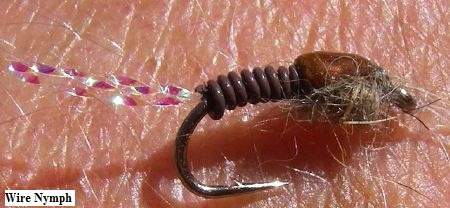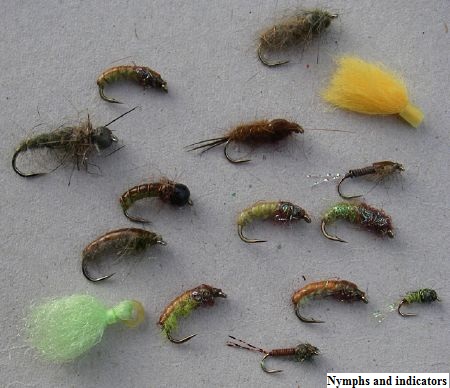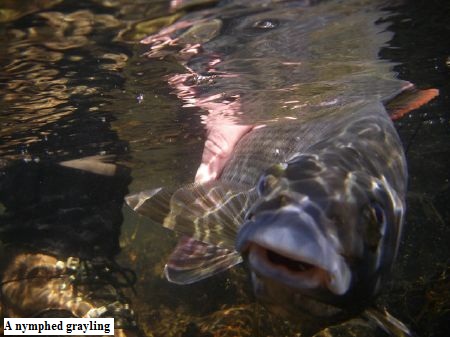Nymph Mania
- Details
- Published on Monday, 06 October 2008 17:31
- Written by Alex Laurie
 It started when I was about 14, I suppose. That is about the age when nymphs did suddenly seem quite attractive to this boy-angler.
It started when I was about 14, I suppose. That is about the age when nymphs did suddenly seem quite attractive to this boy-angler.
Until then, I had been chasing the brownies and the ladies of the stream pretty unsuccessfully, with maggots and worms and occasionally with wet and dry fly. I caught some, but I knew I should have been doing better. Then I read Sawyer.
The Nymphs and the Trout was, and still is, a great angling book. It transported me from my Avon (the Lanarkshire one) to “his Avon”. It really was his Avon, as Frank Sawyer was the keeper on the stretch of the Hampshire Avon at Netheravon. I learned a lot from that book and I’m not alone in that.
Where Frank had the edge on me, apart that is from skill, experience, maturity…was the fact that he could see the fish.
 In those days, his river ran as clear as gin and the fish sat there as if suspended in mid air, so clear was the water. I know this, because I was fortunate enough to fish Frank’s Avon many times, due to the fortunate accident that it flowed through Christchurch, which is close to Bournemouth, which is where my parents took me on holiday. I’ll let that lie for now, but I may come back to this another day, because I really loved fishing that river for the barbel, chub, red finned roach, even the big mullet…and I learned a lot because I too could see the fish and their reactions to my baits.
In those days, his river ran as clear as gin and the fish sat there as if suspended in mid air, so clear was the water. I know this, because I was fortunate enough to fish Frank’s Avon many times, due to the fortunate accident that it flowed through Christchurch, which is close to Bournemouth, which is where my parents took me on holiday. I’ll let that lie for now, but I may come back to this another day, because I really loved fishing that river for the barbel, chub, red finned roach, even the big mullet…and I learned a lot because I too could see the fish and their reactions to my baits.
Meanwhile back at my Avon, I tried to put into practice Frank’s lessons. I greased the butt of my leader. I watched, no I stared at, the hole the leader made in the surface film, and I caught fish. I didn’t begin to match the huge numbers of fish that Sawyer was catching, but I was happy. I started regularly catching fish of a stamp that my downstream wet flies would only occasionally catch.
Fast forward now. Twenty-odd years have gone by and I’ve caught quite a few nice trout and grayling over the years. I’m fishing with an American I met on the banks of a fairly obscure river in New Zealand’s South Island. He is a student and part time fishing guide back home, but very well respected as I later discover. At this point, I’ve had a very good year on the Clyde, but I soon discover we are all just students in this art of angling, and I’ve not done my homework.
 I spot a fish about 6lb. It is a big fish by my standards and lying quite deep in fast swirling water. I decide a nymph is the way to go. I can see the fish from my casting position – a rare luxury.
I spot a fish about 6lb. It is a big fish by my standards and lying quite deep in fast swirling water. I decide a nymph is the way to go. I can see the fish from my casting position – a rare luxury.
I start casting. After several attempts I got a decent cast and drift. The fish moves to the fly and I tighten, but no contact is made. Being a typical New Zealand trout, it exits stage left! My young friend expresses surprise that I’m not using any form of strike indicator. I explain that they just spook the fish and that I do ok without using one. He reckons I may have struck too soon.
He spots the next fish. This one is really deep down and so he puts on a tungsten beadhead, with a yarn indicator above. He starts casting.
Being a guide and a better caster and angler than I am, he covers the fish perfectly first time. Not being used to using an indicator, I being the spotter, watch the fish for a reaction (he can’t see this fish from his position). I’m guessing that the fly is about where the fish is, when suddenly my pal strikes and he is into a hard fighting fish about 5lb. He tells me after I net it that his indicator went down.
No sooner is this fish landed, than I spot another just a few metres upstream. As my pal is already in pole position, I insist that he tries for this one too.
I could go on, but basically the whole scene was replayed and I never saw that fish take the fly either. Since that day, I’ve rarely fished a nymph without some form of strike indication. Occasionally, in really shallow water when I can see the fish clearly, I’ll do without.
Nowadays, my indicators range from dry flies to the bend of which, I tie a short dropper with a nymph below, to wisps and larger portions of yarn that I can slide up and down the line, to foam and balsa floats, for want of a better description. They all have their uses.
It is much more pleasant to cast and aesthetically pleasing to fish with the lightest and least obtrusive indicator possible, but sometimes I have to get down and dirty with the big guns. Casting these beasts overhead is fraught with the ever-present danger of tangling and also danger to thin walled rod blanks, so I tend to use some form of roll cast rather than an overhead cast.
 I always work upstream. The basic method of fishing a light or a heavy rig is to treat the indicator as a dry fly, doing aerial mends, curve casts, wiggles...in fact, the whole spectrum of dry fly casts as well as off-the-water mends. My motto is “as long as it isn’t dragging, let it drift”, meaning that a long drag free drift is the way to more fish. Just the same as dry fly, really.
I always work upstream. The basic method of fishing a light or a heavy rig is to treat the indicator as a dry fly, doing aerial mends, curve casts, wiggles...in fact, the whole spectrum of dry fly casts as well as off-the-water mends. My motto is “as long as it isn’t dragging, let it drift”, meaning that a long drag free drift is the way to more fish. Just the same as dry fly, really.
The rest of it: the depth/weight balance and all that, that is just trial and error, for me at least. Sometimes I get it right straight off. Other times I don’t get it right at all, but I hope this helps give a flavour of my approach to fishing the nymph and why I do it this way.
Alex Laurie , now into his 50th year, has been fishing since the tender age of 12. He used to do a lot of coarse fishing and, until last year, held the Scottish bream record with a 10lb 4oz fish. Alex has fished all over the world, including Alberta Canada and has cast a fly in New Zealand for 5 out of the last 6 years. He prefers rivers, but loves our wild highland lochs too.
Alex works in property management, says he is a frustrated blues guitarist and lives with his very understanding partner Linda in Cambuslang near Glasgow.

